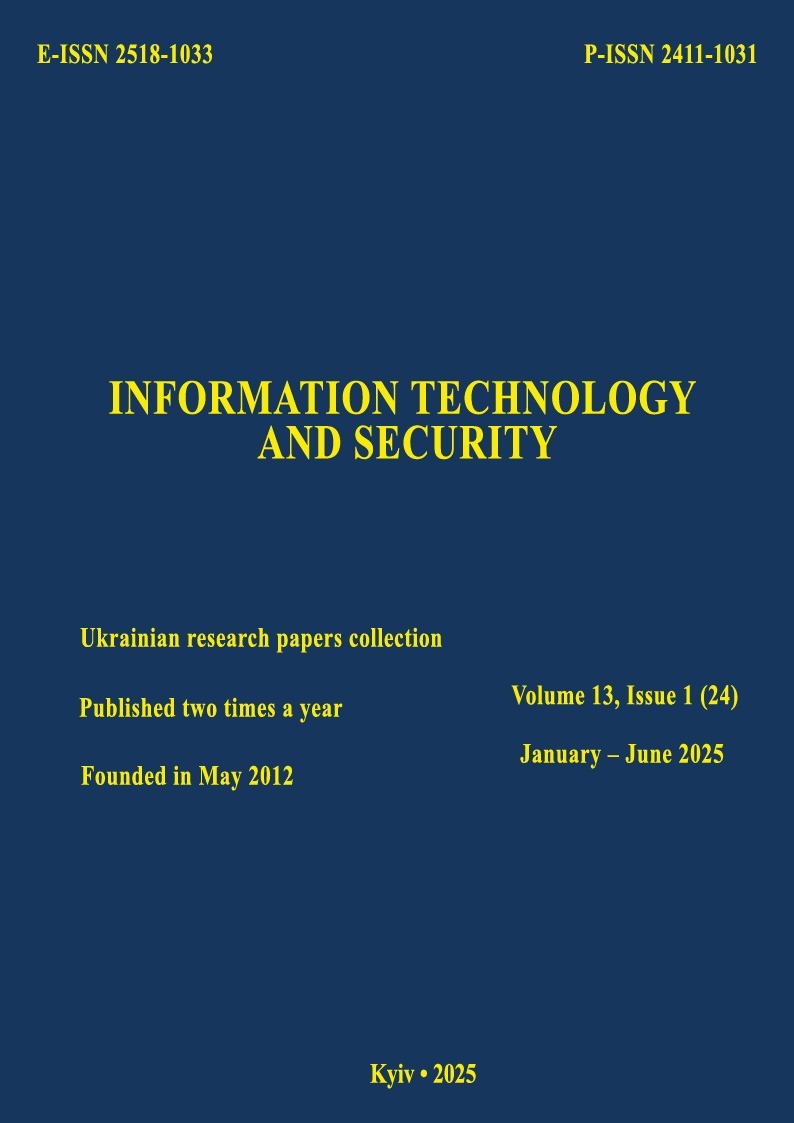Machine learning methods for anomaly detection in the radio frequency spectrum: research methodology
DOI:
https://doi.org/10.20535/2411-1031.2025.13.1.328754Keywords:
artificial intelligence, anomaly detection, machine learning, radio frequency spectrum, classification, Analytic Hierarchy Process (AHP), Isolation Forest, Autoencoder, Local Outlier Factor (LOF), One-Class SVM, Generative Adversarial Networks (GAN)Abstract
The experience of the past three years of full-scale warfare testifies to the dynamic transformation of the conceptual foundations of combat operations and the shifting prioritization of the means employed to conduct them. The emergence and increasingly active use of various unmanned systems, the widespread deployment of precision-guided munitions, and the development of advanced electronic warfare capabilities have collectively underscored the strategic significance of the radio frequency spectrum. The provision of continuous spectral monitoring and the detection of anomalous activity in the electromagnetic environment have become critically important components of electronic warfare systems, signals intelligence, and secure communications networks. Traditional approaches to signal analysis – based on fixed thresholds, heuristic rules, or a priori statistical assumptions – are proving insufficiently effective in the highly dynamic and noiseintensive environment of the modern electromagnetic battlespace. In this context, there arises a need to investigate innovative approaches, particularly machine learning methods, for their ability to enable the automatic detection of anomalous signals without reliance on labeled data. Such solutions are expected to enhance the accuracy, adaptability, and response speed of spectral monitoring systems. A research methodology is proposed to assess the feasibility of applying machine learning methods to the task of anomaly detection in the radio frequency spectrum, taking into account the complexity of the data structure, its high dimensionality, and the limited availability of a priori information regarding anomalous samples. This research methodology encompasses the following stages: formulation of the experimental task; selection of anomaly detection methods for experimental evaluation; determination of evaluation metrics; selection and/or generation of test datasets; direct execution of the experimental study; analysis and assessment of the results; visualization and interpretation of the obtained findings; formulation of conclusions based on the experimental outcomes. This article focuses on the theoretical framework of the experimental study. Practical results will be published separately.
References
I. Burgetova, P. Matousek, and O. Rysavy, “Anomaly Detection of ICS Communication Using Statistical Models”, in Proc. 17th Int. Conf. on Network and Service Management (CNSM), Izmir, Turkey, 2021, pp. 166-172.
J. Hochenbaum, O. S. Vallis, and A. Kejariwal, “Automatic Anomaly Detection in the Cloud Via Statistical Learning”, arXiv preprint arXiv:1704.07706, Apr. 2017. [Online]. Available: https://arxiv.org/abs/1704.07706. Accessed on: Jan. 28, 2025.
Y. Cissokho, S. Fadel, R. Millson, R. Pourhasan, and P. Boily, “Anomaly Detection and Outlier Analysis”, Data Science Report Series, University of Ottawa, Ottawa, Canada, 2020. [Online]. Available: https://www.data-action-lab.com/wp-content/uploads/2020/09/DSRS_ADOA.pdf. Accessed on: Feb. 02, 2025.
S. Tschimben, and K. Gifford, “Anomaly Detection with Autoencoders for Spectrum Sharing and Monitoring”, in Proc. 2022 IEEE Communications Quality and Reliability Workshop (CQR), Arlington, VA, USA, Sept. 13, 2022, pp. 37-42, doi: https://doi.org/10.1109/CQR54764.2022.9918589.
N. S. Senol, M. Baza, A. Rasheed, and M. Alsabaan, “Privacy-Preserving Detection of Tampered Radio-Frequency Transmissions Utilizing Federated Learning in LoRa Networks”, Sensors, vol. 24, no. 22, p. 7336, Nov. 2024, doi: https://doi.org/10.3390/s24227336.
N. S. Senol, M. Baza, A. Rasheed, and M. Alsabaan, “Identifying Tampered Radio-Frequency Transmissions in LoRa Networks Using Machine Learning”, Sensors, vol. 24, no. 20, p. 6611, Oct. 2024, doi: https://doi.org/10.3390/s24206611.
The scikit-learn developers, “sklearn.ensemble.IsolationForest”, scikit-learn 1.6.1 documentation, [Online]. Available: https://scikit-learn.org/stable/modules/generated/sklearn.ensemble.IsolationForest.html. Accessed on: Feb. 03, 2025.
Y. Lim, “Unsupervised Outlier Detection with Isolation Forest”, Medium, Mar. 17, 2022. [Online]. Available: https://medium.com/@limyenwee_19946/unsupervised-outlier-detectionwith-isolation-forest-eab398c593b2. Accessed on: Feb. 03, 2025.
The scikit-learn developers, “sklearn.neighbors.LocalOutlierFactor”, scikit-learn 1.6.1 documentation, [Online]. Available: https://scikit-learn.org/stable/modules/generated/sklearn.neighbors.LocalOutlierFactor.html. Accessed on: Feb. 03, 2025.
A. Athalye, C. Northcutt, and J. Mueller, “Class Imbalance, Outliers, and Distribution Shift”, Introduction to Data-Centric AI, MIT CSAIL, Jan. 19, 2024. [Online]. Available: https://dcai.csail.mit.edu/2024/imbalance-outliers-shift/. Accessed on: Feb. 05, 2025.
O. Rainio, J. Teuho, and R. Klén, “Evaluation metrics and statistical tests for machine learning”, Scientific Reports, vol. 14, Art. no. 6086, Mar. 2024, doi: https://doi.org/10.1038/s41598-024-56706-x.
J. Brownlee, “ROC Curves and Precision-Recall Curves for Imbalanced Classification”, Machine Learning Mastery, Oct. 12, 2019. [Online]. Available: https://machinelearningmastery.com/roc-curves-and-precision-recall-curves-for-imbalanced-classification/. Accessed on: Feb. 05, 2025.
C. C. Aggarwal, Outlier Analysis, 2nd ed. Cham, Switzerland: Springer, 2017.
T. L. Saaty, Fundamentals of Decision Making and Priority Theory with the Analytic Hierarchy Process, Pittsburgh, PA: RWS Publications, 2000.
Downloads
Published
How to Cite
Issue
Section
License
Copyright (c) 2025 Collection "Information Technology and Security"

This work is licensed under a Creative Commons Attribution 4.0 International License.
The authors that are published in this collection, agree to the following terms:
- The authors reserve the right to authorship of their work and pass the collection right of first publication this work is licensed under the Creative Commons Attribution License, which allows others to freely distribute the published work with the obligatory reference to the authors of the original work and the first publication of the work in this collection.
- The authors have the right to conclude an agreement on exclusive distribution of the work in the form in which it was published this anthology (for example, to place the work in a digital repository institution or to publish in the structure of the monograph), provided that references to the first publication of the work in this collection.
- Policy of the journal allows and encourages the placement of authors on the Internet (for example, in storage facilities or on personal web sites) the manuscript of the work, prior to the submission of the manuscript to the editor, and during its editorial processing, as it contributes to productive scientific discussion and positive effect on the efficiency and dynamics of citations of published work (see The Effect of Open Access).

